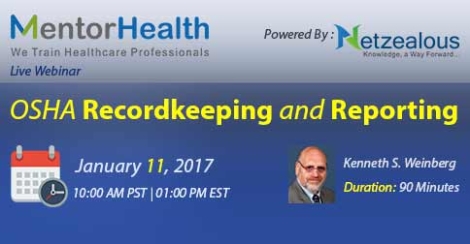Overview:
OSHA requires that businesses maintain a running account of injuries and illness that occur in the workplace. The logs must be completely and accurately filled in and completed. At the end of the year, these figures must be reported to OSHA or other report collection agencies t0o determine if the rate of injuries and illnesses falls within the norm for that industry sector. Although not a recommended practice, some businesses use these figures as a measure of the success or failure of their safety programs. Over reporting injuries and illnesses or under reporting such numbers can result in problems, both internally in a company, as well as with the regulatory agency. Accurate reporting is imperative, and is a good tool to use in determining problem areas in the company's business operation.
Why should you attend:
Those responsible for maintaining filling out and recording injuries and illnesses are often confused by what should and should not be included in the OSHA recordkeeping forms. Over-reporting injuries and illnesses can be as serious as under-reporting injuries and illnesses, and can even lead to uncomfortable OSHA inquiries or even inspections. It is also difficult to know how to accurately account for time lost due to injuries and illnesses, especially in the case of a part-time work force. This webinar will help clarify what should be reported as an injury or illness, as well as how to account correctly for lost work time.
Many employers are also confused by which forms should be used to initially report injuries and illness, and those that should be used for submission to OSHA or the proper reporting agency. This session will discuss these and in addition, suggestions will be offered for maintaining confidentiality of the OSHA Injury and Illness data.
Areas Covered in the Session:
Criteria to use in determining whether and injury or illness should be reported on the OSHA Log
Understand the purpose of the OSHA Injury and Illness logs and forms
Potential new requirements under the law
How to calculate lost work days?
Techniques to assure that the information contained in the logs remains confidential
How to calculate injury and illness rates for their workplace?
Who Will Benefit:
Safety Personnel
Occupational Health Personnel
Human Resources Administrators
Supervisors
Managers
Small Business Owners
Speaker Profile:
Kenneth S. Weinberg is an independent consultant in environmental health and safety. Dr. Weinberg has consulted for several companies in the areas of OSHA Injury and Illness reporting, as well as auditing for OSHA inspections. He has worked as the Director of Safety at Mass. General Hospital in Boston for almost twelve years, and has written several books on the topics of health care safety, OSHA, and Indoor Air Quality. He has also written several articles for prominent national safety publications, and serves on the editorial advisory boards for safety publications. He Also has been Administrator of the Health Care Divisio0n of the American Society of Safety Engineers, and is a member of several panels that advice on safety related matters.
When
11 Jan 2017 @ 10:00 am
11 Jan 2017 @ 11:30 am
Duration: 1 hours, 30 minutes
Where
Language
English en
